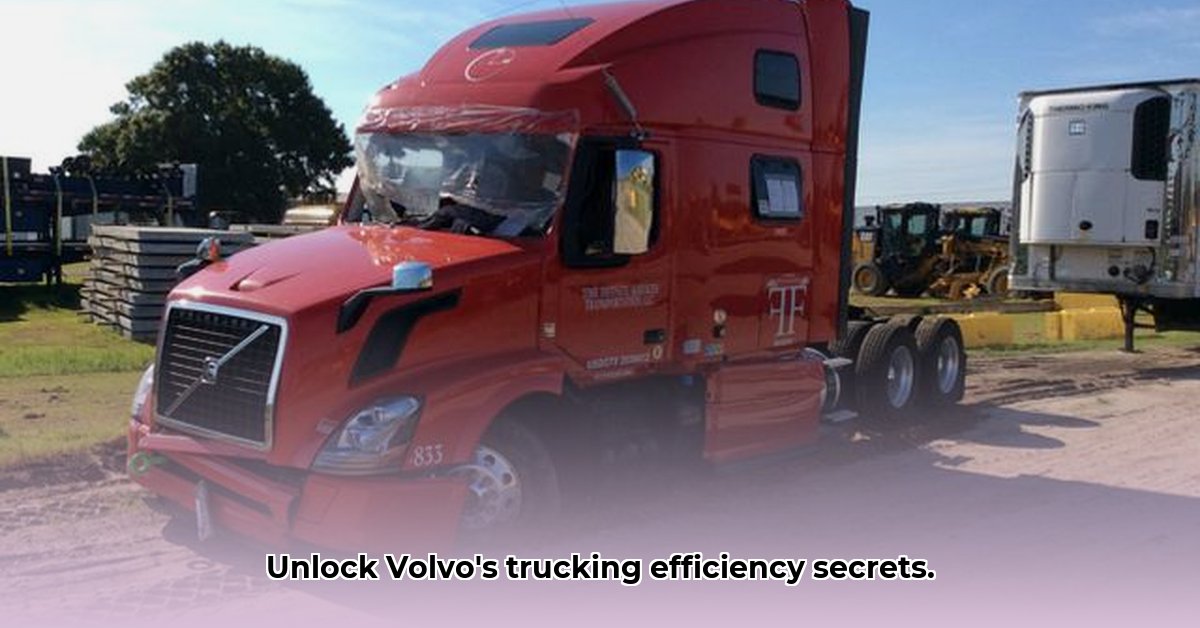
Engine Performance: Power and Efficiency on the Road
The 2017 Volvo lineup frequently featured the D13 engine, a powerful and relatively fuel-efficient inline-six (cylinders arranged in a single row). Horsepower and torque varied depending on the specific configuration, generally ranging from 455-505 horsepower and 1,750-1,850 lb-ft of torque. This smooth operation, combined with its durability under heavy loads, made it a popular choice. Transmission options often included Volvo's I-Shift automated manual transmission, known for smooth shifting and fuel-saving capabilities. Different axle ratios were also available, optimizing performance for various applications (highway hauling versus stop-and-go city driving). Regular maintenance, according to the owner's manual, is paramount for extending engine and drivetrain lifespan. Isn't maximizing your engine's longevity a key factor in long-term cost savings? For more detailed specifications, check out this helpful resource: Volvo Truck Specs.
Safety Features: Prioritizing Protection on the Road
Safety was a core design element in 2017 Volvo trucks. Standard features typically included electronic stability control (ESC), anti-lock brakes (ABS), and advanced driver-assistance systems (ADAS). These ADAS features might have included adaptive cruise control (maintaining a safe following distance), lane departure warnings (alerting drivers to unintentional lane drifts), and collision mitigation systems (automatically applying brakes to lessen the impact of or potentially avoid collisions). Regular calibration and maintenance of these safety systems are crucial for optimal performance, contributing to both driver and overall road safety. Given the potential for significant accidents, shouldn't maximizing the effectiveness of safety systems be a top priority?
Driver Comfort and Ergonomics: Enhancing Productivity Through Design
Driver comfort significantly impacts productivity and safety. The 2017 Volvo cab design emphasized ergonomics, placing controls within easy reach and arranging the dashboard for intuitive operation. Generously padded and highly adjustable seats, offering excellent lumbar support, reduced back strain during long hauls. A comfortable driving environment directly contributes to reduced driver fatigue and increased safety. Isn't investing in driver comfort a worthwhile investment in productivity and reduced accident risk? Independent studies have correlated reduced driver fatigue with heightened safety and efficiency.
Maintenance and Common Issues: Ensuring Reliable Operation
Preventative maintenance is essential for optimal performance and preventing costly repairs. This includes regular checks of fluids (engine oil, coolant, transmission fluid, brake fluid), filters (air, fuel, oil), and belts. Following the manufacturer's recommended maintenance schedule (found in the owner's manual) is crucial. Maintaining detailed records of all maintenance and repairs is also highly recommended for regulatory compliance and tracking. While the 2017 Volvo trucks generally exhibited high reliability, some recurring issues were reported by owners. These often included problems with specific electrical components and occasional air conditioning system malfunctions. Proactive maintenance helps prevent minor problems from escalating into major breakdowns. How can you minimize costly downtime and maximize operational efficiency? Proper maintenance is your answer.
Modifications and Upgrades: Optimizing Performance
Many owners personalize their trucks for enhanced performance, comfort, or efficiency. Popular modifications include aerodynamic add-ons (fairings), upgraded lighting systems, and additional storage solutions. However, it's critical to ensure compatibility with existing systems and regulatory compliance before making any modifications. Consulting experienced mechanics or modification specialists is advisable, particularly for complex upgrades involving engine or drivetrain alterations to avoid unintended consequences. Remember to consult your owner's manual and consult with professionals for optimal changes. What modifications would best suit your specific needs and operating conditions?
Fuel Efficiency: Minimizing Operating Costs
Fuel efficiency was a key selling point for the 2017 Volvo. Features like aerodynamic design, the I-Shift transmission's intelligent gear selection, and advanced engine management systems contributed to fuel economy. However, real-world fuel efficiency depends on driving style, terrain, and cargo weight. Proper tire pressure is also critical. Regular tire pressure checks, according to the owner's manual is crucial for both fuel economy and extended tire life. What strategies can significantly reduce your fuel costs? Proper tire inflation and a cautious driving style are key.
Comparison to Competitors: Assessing its Place in the Market
The 2017 Volvo's value proposition is best understood by comparing it to its contemporary competitors, such as Freightliner Cascadia, Kenworth T680, and Peterbilt 579. Factors to consider include fuel economy, payload capacity, driver comfort, and maintenance costs. Remember that models within each manufacturer's lineup can also offer varying advantages. A thorough comparison is crucial before making any purchase decision. What factors are most important to you in selecting the right truck for your business?
Conclusion: A Comprehensive Guide to the 2017 Volvo Tractor Trailer
This guide provides a comprehensive overview of the 2017 Volvo tractor-trailer. Further research, including consulting the owner's manual and seeking advice from experienced mechanics and Volvo technicians, is highly recommended for anyone considering purchasing or operating this vehicle. Understanding your vehicle's capabilities and limitations ensures optimal performance and long-term success. What steps will you take to maximize your 2017 Volvo's efficiency and safety?